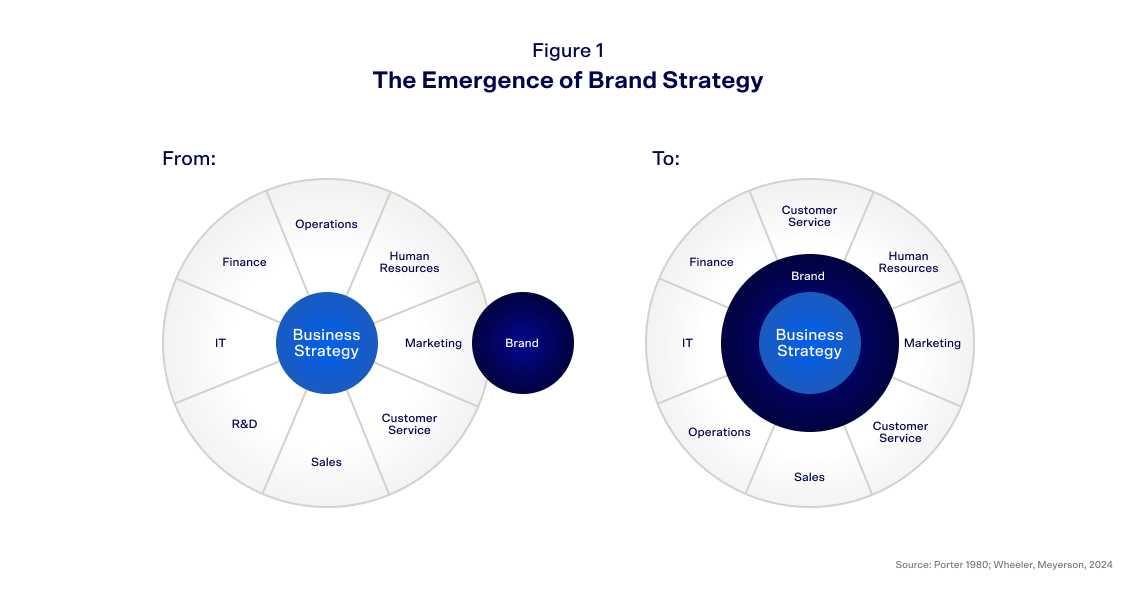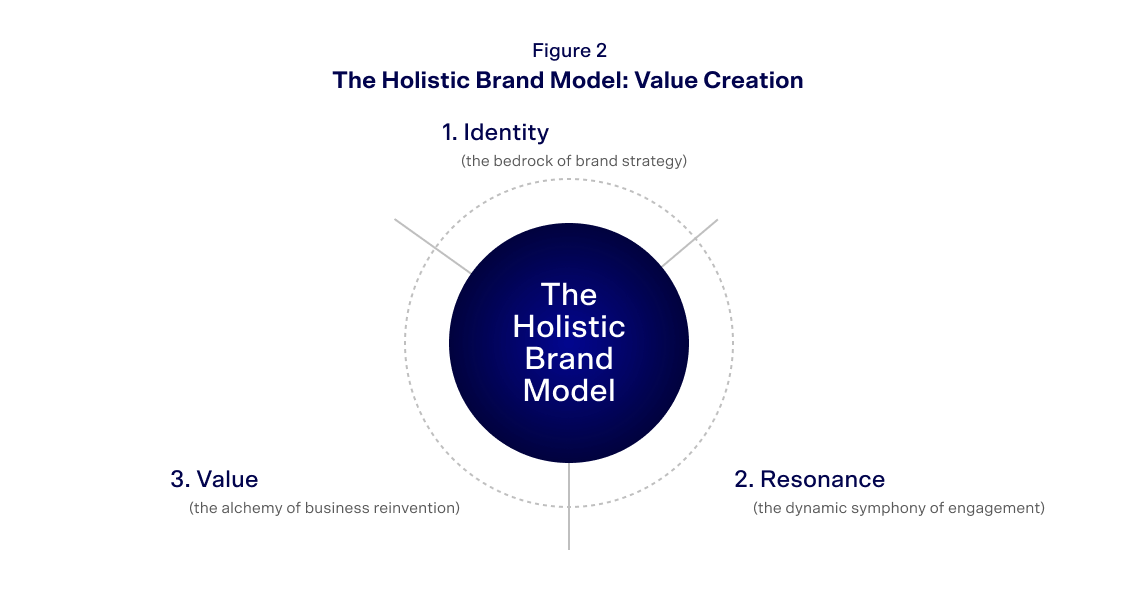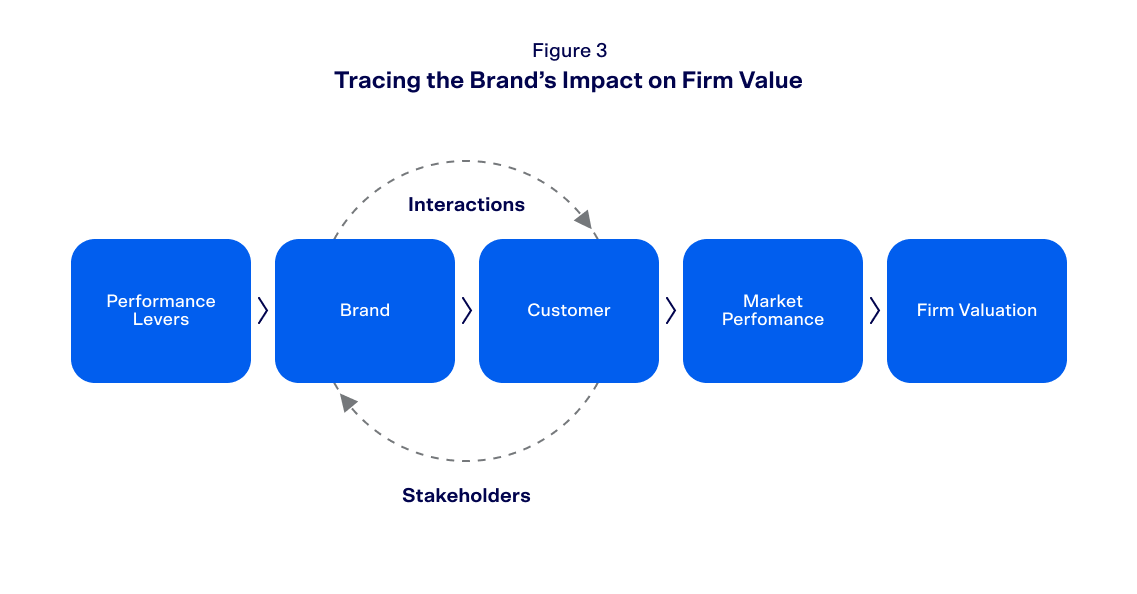Brands have never mattered more than they do today. Yet, branding—this force that drives businesses forward—has lagged behind the world’s march of progress. Innovation in branding stumbles while technology like AI races ahead, reshaping our lives, our work, our futures. We face an age of explosive change, yet we’re still saddled with old, worn-out models, struggling to keep up. Like showing up to a gunfight armed with nothing but a knife.
The Holistic Brand Model aims to fix this. It’s a new way of looking at brands—a fresh framework that sees them not just as names or logos or advertising effectiveness, but as powerful engines for growth. This isn’t about discarding the old ways. It’s about standing on the shoulders of the giants—Kapferer, Aaker, Keller—and moving beyond. These men built the framework we know, the scaffolding we’ve climbed. But the winds have shifted. It’s time for new stories to be told in the evolving world of brand strategy.
That scaffolding? It’s the evolution of branding into a key piece of business strategy. Picture it: the face of your business strategy, as vital as any other part of the machine. Back in the 1980s, Harvard Professor Michael Porter painted it clearly—a wheel, with strategy at the center and the spokes stretching out to marketing, innovation, human resources, and more (Figure 1).

But today, the picture has changed. Branding is no longer a cog in the machine. It’s the machine itself. This shift began in the 1980s when John Murphy showed the world that brands had value beyond just recognition—they had financial worth. They were assets to be measured in dollars and cents, nurtured, grown. Brand equity was born.
Not long after, Gary Hamel and C. K. Prahalad added to this with their ideas on growth and innovation. In Competing for the Future, they showed how a company’s current strengths could shape its future—how businesses must anticipate what the customer will need tomorrow and be ready to deliver it. One of these strengths was the brand. It was a call to arms for those who would shape the future, not just react to it.
The 1990s came with more breakthroughs, thanks to the work of academics, companies, and agencies alike. David A. Aaker and Kevin Lane Keller became the guiding lights, my colleagues and good friends. They offered models that carved a path through the stormy seas of brand strategy—models of identity, of resonance, of connection with consumers. They have stood tall through the decades.
But now, as we stand at the edge of a new era, those models—while still respected—feel like they belong to a different time. Aaker’s Brand Identity System and Keller’s Brand Resonance model were vital, but they are stories from another chapter, written before technology reshaped the world. Now, we need something more.
We are no longer content with the incremental steps of the past. It’s time to leap forward. Branding must now be about creating value—true internal value, not just in perception, but in the heart of the business itself. Brand identity, resonance, and value must now meet at a single point, pulling us into the future.
The Holistic Brand Model is my answer. It’s not just the next step in the journey—it’s a whole new frontier.

It is not necessary to discuss the first leg of the stool of the holistic brand model – Identity, the bedrock of brand strategy, or the second leg of the stool, the dynamic symphony of engagement. In brief they can be summarized as follows:
1. Identity: Building from the Inside-Out
The identity-driven approach to branding begins with a brand’s core essence, rooted in the company’s culture, values, and capabilities. This approach draws from foundational frameworks like Aaker’s brand identity system and Kapferer’s brand identity prism, but expands further to position the brand as a cultural and symbolic entity that embodies deeply held beliefs and values. Brands like Harley-Davidson, Virgin, and Birkenstock exemplify this approach by creating strong internal identities, which anchor their brand stories, employee culture, product design, and marketing in authentic, value-based narratives.
This approach emphasizes authenticity and consistency, ensuring the brand represents something larger than its products. It actively creates a sense of belonging among consumers by aligning with their personal values and cultural identity. In this view, brand strategy sets the long-term compass, while branding (the management of perceptions) becomes a tool to deliver that strategy. Brands such as Glossier and Liquid Death demonstrate how this identity-driven method helps newer brands establish cultural relevance quickly by forging strong emotional connections through storytelling, community-building, and shared purpose.
2. Resonance: Building from the Outside-In
The resonance-driven approach, rooted in Kevin Lane Keller’s Customer-Based Brand Equity (CBBE) model, shifts the focus from internal identity to how brands embed themselves into the consumer’s mind and experience. This outside-in approach views branding as a dynamic process of building mental availability, emotional connection, and ultimately brand loyalty through ongoing consumer engagement. The brand resonance pyramid highlights that strong brands achieve not just awareness and favorable associations, but deep psychological bonding, where the brand becomes part of the consumer’s identity and lifestyle.
Keller’s framework is inherently customer-centric and performance-focused, linking marketing investments directly to brand equity growth, market performance, and even financial value. This is why companies like American Express, Disney, and Procter & Gamble have adopted the model to systematically manage and measure brand health and effectiveness over time. The model also seamlessly integrates newer engagement mechanisms such as social media, user-generated content, and social currency — ensuring that brands remain relevant by adapting to evolving consumer behavior and cultural shifts.
The third leg of the stool of the Holistic Brand Model is where branding of old meets the challenges of branding in the future, a world of significant innovation in technology, culture and economics.
3. Value: The Alchemy of Business Reinvention
The third pillar of the Holistic Brand Model is value—a transformative perspective that positions branding as a catalyst for systemic reinvention and exponential growth. Once regarded as intangible assets influencing consumer perceptions, brands have evolved into powerful multipliers, amplifying every component of a company’s business model, ecosystem, and even entire categories. This shift redefines branding, transforming it from its traditional role into a driver of sustained value creation, innovation, and strategic reinvention.
Broadening the Brand’s Role
In this new paradigm, brands are no longer just assets confined to intangible goodwill but brands emerge as central forces embedded within ecosystems, creating value across firms and networks.
The measurement of branding’s impact through short-term soft metrics like followers, clicks, and impressions that is still so popular today among marketers simply makes no sense in this new world of branding. Today, the focus shifts to long-term value creation, aligning branding with corporate performance metrics, the intrinsic value of a firm based on earnings, growth potential and cashflow, particularly discounted cashflow which is part of the corporate valuation theory, the de facto standard for CEOs, CFOs, and investors.
This reframing elevates branding’s role to that of a strategic imperative of value creation. Research underscores brand’s transformative power: A firm with a strong brand on average delivers 3x higher economic value than an equivalent weakly branded competitor (Stewart Stern). Why? Because it accelerates the performance of the underlying business, and it creates an ever harder impenetrable moat (Paul Worthington).
There are four factors that contribute to this expanded role of the brand and long-term value creation: 1) new ways to building strong brands, 2) brands as ecosystem multipliers 3) future-back approach to branding, and 4) brand relevance and monetization.
1. New Ways of Building Strong Brands
We have arrived at the third and new way of how strong brands are built. First, was the traditional approach to brand value creation, built around mass-media and isolated impressions and one-size-fits-all strategies. This historical model followed a linear path —marketing investments (e.g., advertising, product innovation) led to brand impressions (awareness and trust), which influenced consumer behavior and, ultimately, firm performance (see Path 1 in Figure 3). While this remains relevant today, we have experienced over the past decades the second way. Technological advancements, the rise of social media, search engines, programmatic advertising, and AI, have enabled a customer-centric model that is hyper-targeted, data-driven, and democratized. Smaller businesses and influencers now compete with established corporations, while platforms foster brand communities and advocacy. This evolution transformed consumers into loyal ambassadors, extending the brand’s reach and relevance.
However, this customer-centric model is also facing challenges, and appears to run out of steam. Recent studies at Oxford University reveal that only 1% of campaigns achieve exceptional results, while the majority yield mediocre outcomes.

There is now a third way of building strong brands. To succeed today and in the future, brands, so argues Joachimsthaler in his book The Interaction Field, must embrace a new model and path of continuous engagement, participation and collaboration among multiple stakeholders. He sees this as a new path to value creation—one that relies on data, analytics, and collaborative and meaningful exchanges or interactions (see Path 2 in Figure 3). This approach generates network effects, where the value of a brand or platform increases as more participants join, viral effects, where content spreads organically, amplifying engagement, and learning effects, where insights from interactions drive continuous improvement and innovation.
Brands like Uber, Airbnb, and Amazon exemplify this new path of how brands are built and create value. Airbnb’s “belong anywhere” promise is brought to life not just via brand campaigns but through millions of host-traveler interactions, building trust and reinforcing its community-driven ethos. It is the interactions rather than impressions through advertising that builds the brand with multiple stakeholders, beyond just travelers and hosts.
2. Brands as Ecosystem Multipliers
In the new paradigm, the multiple stakeholder perspective changes where and how value is created by brands; they now act as value multipliers across entire ecosystems. A brand’s influence now extends to suppliers, partners, and stakeholders, enhancing performance and value at every level. For example, Nike’s brand equity commands premium supplier relationships, ensuring consistent demand and profitability, Nvidia’s reputation strengthens its ability to secure long-term contracts in the B2B market.
This aligns with the inverted firm model by Van Alstyne and Parker, where value creation shifts from internal control within a single organization to external orchestration in an ecosystem. Brands like Apple and Amazon illustrate how orchestrating trust, loyalty, and differentiation beyond their organizations and within a broader ecosystem creates enduring competitive advantages and value.
A prime example of an “ecosystem brand” is Apple. It creates value not only at Apple itself but externally, through orchestrating a network of ecosystem partners and stakeholders. Apple offer a wide range of interconnected products and services like iPhones, Mac computers, Apple Music, and Apple TV, creating a comprehensive user experience within their own ecosystem where different products seamlessly work together which enables the value multipliers and supports the premium prices.
3. A Future-Back Approach to Branding
Looking at brands as amplifiers or multipliers of a business or an entire ecosystem also means that a new, proactive, long-term perspective of value creation is necessary. Just like investors have expectations about the future, a brand’s value needs to be determined from this future vantage point. Today’s approach of valuating brands on the basis of discounted cashflow projected into the future seems wholly wrong. It assumes a stable set of needs evolving along a trendline over the next years to come based on the past.
Instead, today’s consumer needs, need states and lifestyle are evolving and changing ever faster due to technological advancements, cultural shifts, economic uncertainty, and changing values. These changes converge rapidly creating new consumer realities, future need states and life scenarios. The future does not fit into the containers of the past.
Consider today’s silent or quiet and understated luxury phenomenon. Just five to ten years ago, it was unthinkable. We used to live in a logo-heavy luxury world and flashy wealth display. Think Gucci, Balenciaga and Supreme collabs. Today, low-key brands like Loro Piana, the ultra stealth brand, The Row with its minimalist luxury or Brunello Cucinello & Zegna and its quiet luxury menswear have become more desirable.
Think AI ten years ago. At best it was considered a business tool, not a personal assistant. Today, we treat AI as if it were a friend, therapist, or creative collaborator. ChatGPT has harnessed this positioning as an everyday thought partner, personal researcher, and creative tool.
A future-back approach is unconstrained from the past because it starts not with what exists, it ignores today’s limitations, it projects observable actions into the future, rather than preferences, attitudes and needs. It analyzes behaviors, observable actions, what people do, not just subjective preferences and attitudes, what people say, that are prone to fluctuations. It asks: what must be true to create the future, focusing on possibilities, rather than on limitations.
4. From Marketing Products to Marketing to Situations
In a future-back framework, branding shifts from marketing products to consumers to marketing to situations, lifestyles, and workflows or even future need states. Think for example how tequila used to be sold based on traditional product attributes like smoothness, quality and heritage. Instead, brands like Don Julio 1942 or Casa Dragones focus on being an essential part of curated experiences. Don Julio positions as the bottle for VIP nightlife status, and Casa Dragones positions as the choice for high-end dinner parties and art-world insiders. Or consider the world of hospitality, the old model is one of promoting rooms for a price based on amenities. Instead, SoHo House and Aman don’t sell rooms – they sell membership to an exclusive, status-driven global lifestyle, a way to plug into a high-net-worth social ecosystem.
Marketing to situations also changes what consumers consider a fair consumer contract. It used to be: give me a great product and I’ll give you my money. Today consumers demand a new value exchange, a fairer one. Instead of paying for a product or for usage, the new model is to pay for the outcome. The old model is: buy a $200 serum and hope it works. The new model is: AI-driven, results-based skincare subscriptions that adjust based on real-time skin data, and pay only if your skin improves, tracked through facial scanning technology.
By aligning with evolving lifestyles and challenges, brands change how consumers perceive their relevance or importance in life. This can give brands permission to monetize the value they create for consumers in new ways, while deeply connecting with them. AI already made this type of monetization a reality in software, where technology firms sold software on a per seat or usage bases, known as Software as a Service. Caption Health, a GE company sells AI-guided ultrasound. It helps clinicians perform and interpret ultrasound exams. Instead of paying for the software, imaging centers or hospitals only pay based on diagnostic accuracy and improved patient throughput, essentially improving clinical outcomes such as faster diagnosis or lower error rates which delivers value. Zapier automates tasks and workflows for over 2 million customers and charges based on tasks automated.
In traditional SaaS, the consumer contract is: use it or not, you still pay. In Service as a Software AI the contract is: if the AI delivers measurable value, you pay a share. This appears to be a fairer consumer contract, where risk is transferred to the seller, who makes the promises to consumers or customers.
The Role of Brands in Reinvention
The third pillar of the Holistic Brand Model redefines branding as a driver of systemic reinvention, not just a tool for perception management. By integrating long-term vision, ecosystem collaboration, and future-forward thinking, brands become transformative forces capable of creating value for entire networks. This is the alchemy of business reinvention: envisioning the future, orchestrating change, and leading industries toward sustainable, exponential growth.
There is growing evidence that this new perspective is taking hold:
- Shift from brand-centric to customer-centric activities: There’s a clear movement towards understanding how a brand influences customer behavior throughout their entire experience, from usage to the activities around the customer journey. Traditionally, brand strategy focused heavily on the top of the purchase funnel. Today, the brand’s role extends much deeper. Innovation teams now focus on the entire customer journey, not just segments or personas, seeking opportunities to create new concepts. Brands have become central in orchestrating customer experiences, which in turn builds customer equity, a key driver of company value.
- Shift in branding responsibilities beyond the CMO: There’s also a noticeable redistribution of branding responsibilities across organizations. Some companies, like UPS, have even replaced the Chief Marketing Officer (CMO) role with more strategic positions like Chief Growth Officer, Chief Experience Officer, Chief Data and Technology Officer, or Chief Customer Officer. In other cases, the CMO role has evolved, as seen with Coca-Cola, where expanded responsibilities and new skills are needed to thrive in a data-driven era, improving customer engagement and business outcomes.
A Dynamic Process: Brand as Action
The paradigm has shifted from static brand definitions to a dynamic process. Now, brand strategy is an ongoing narrative driven by data, analytics, and technology like a two-step tango, with frequent interactions creating meaning (often referred to simply as: fast and do) and perceptions through impressions (slow and think). This approach delivers value through learning, virality, network effects when interactions are captured by technology, and effectively attracts consumers and other stakeholders to the brand.
This changes the role of the brand from merely a means to come easy to mind during purchase to an accelerator or multiplier of the value of the business. It’s a holistic journey that guides the customer from the first touchpoint to the last and beyond in daily routines, workflows activities or lifestyle practices, delivering enormous value for a business and corporate valuation that is meticulously measured and optimized. And enormous is the value. With Apple’s market cap at $3 trillion, a comprehensive analysis of decades of empirical study by Srinivasan and Hanssens has shown the brand effect to be 0.33. This means that for every 1% increase in brand strength, Apple adds about $10 billion to its market cap or firm value.
In this new era, our holistic brand model is not just a theoretical construct, a justification for the latest spray and pray campaign or a romantic dream of hopeful value creation through H2 or H3 innovations but a practical toolkit for navigating the complex interplay of identity, resonance, and value creation. It offers a blueprint for brands to not only declare their role in the world but to act upon it, creating a legacy of value that resonates through the annals of time.
As we enter this new era, let us embrace the holistic brand model as our compass, guiding us through the uncharted territories at the amazing frontier of today’s emerging technologies. Herein lies the path to not just surviving but thriving in the Age of Automation, Augmentation and AI, here every brand has the potential to become a beacon of non-linear or even exponential value creation in a world hungry for meaning and connection.
REFERENCES
- Aaker, David A. and Erich Joachimsthaler (2000, 2009), Brand Leadership: Building Assets in an Information Economy,” The Free Press, And Pocketbook London.
- Aksehirli, Zeynep, Bart, Yakov, Chan, Kwong, Pauwels, Koen (2023), Break the Wall: Why and How to Democratize Digital in your Business, Emerald Publishing
- Bell, J. Jason, Felipe Thomaz, and Andrew T. Stephen (2024), “Beyond the Pair: Media Archetypes and Complex Channel Synergies in Advertising,” Journal of Marketing, Nov 26; https://doi.org/10.1177/00222429241302808
- Bharat N. Anand and David Collis (2024) “Why Multibusiness Strategies Fail and How to Make them Succeed” – HBR, Sep/Oct 2024.
- Coleman, Darren (2018), Building Brand Experiences: A Practical Guide to Retaining Brand Relevance, Kogan Page.
- Collis, David and Michael Rukstad (2008), “Can you Say What your Strategy Is?,” HBR, April.
- Collis, David (2021) “Why do so Many Strategies Fail?” HBR, Jul/Aug 2021.
- Corbett, Johnny (2023), “Three Ways Brand Building is Similar to Compound Interest,” Marketing Week, Nov 27.
- Field, Peter and Les Binet (2013), The Long and the Short of it: Balancing Short and Long-Term Marketing Strategies, Institute of Practitioners in Advertising.
- Fombrun, Charles (2003), Fame and Fortune: “How Successful Companies Build Winning Reputations, 1st Edition, FT Press.
- Hamel, Gary and C.K. Prahalad (1996), Competing for the Future, Harvard Business School Press
- Harrison, Dale (2025), The Value of Brand Marketing, Linkedin post, January.
- Holt, Douglas and Douglas Cameron (2012), Cultural Brand Strategy: Using Innovative Ideologies to Build Breakthrough
- Brands, Oxford University Press.
- Joachimsthaler, Erich (2007), Hidden in Plain Sight, How to Find and Execute Your Next Big Growth Strategy, Harvard Business School Press.
- Joachimsthaler, Erich (2020), The Interaction Field: The Revolutionary New Way to Create Shared Value for Businesses, Customers, and Society, Public Affairs.
- Joachimsthaler, Erich, Anne Olderog, Lal Kogoglu, and Sabrina Romviel (2024), “The Vivaldi AI Value Model: How AI Creates Value for Businesses and Brands” – Vivaldi Working Paper, Feb 12\
- Joachimsthaler, Erich (2024), “Business Reinvention Through AI,” TheNTWRK, May, 28
- Joachimsthaler, Erich (2024), “Giorgio Armani – The Art of Building a Brand and a Legacy” in: Giorgio Armani: L’Uomo Il
- Marchio l’Azienda, Frank Pagano and Marco Di Dio Roccazzella (Eds.), Il Sole 24 Ore.
- Joachimsthaler, Erich, Blanchon-Ehrsam, Agathe, Zinnbauer, Markus, (2019) “Hidden in Plain Sight: How to Create Your Company’s Next Big Growth Strategy: 10 Years Later” in Marketing Wisdom, Kartikeya Kompella (Ed.), Springer.\
- Kantar (2024), “Blueprint for Brand Growth…And how CMOs can Operationalize It.”
- Kapferer, Jean-Noel (1994), Strategic Brand Management: New Approaches to Creating and Evaluating Brand Equity,” The Free Press.
- Keller, Kevin Lane (1993) “Conceptualizing, Measuring, and Managing Customer-Based Brand Equity,” Journal of Marketing, Vol. 47, No. 1, Winter, 1983 pp. 1-22
- Keller, Kevin and Srinivasan, Vanitha (2019), Strategic Brand Management: Building, Measuring, and Managing Brand Equity, Global Edition, 5th Edition, Pearson Education Limited.
- Keller, Kevin, Sternthal, Brian, Tybout, Alice M. (2002) “Three Questions You Need to Ask About Your Brand”, HBR, September.
- Knowles, Jonathan (2024), “Brands are Multipliers, not Assets in Themselves,” Marketing Week, April
- Kuehlwein JP and Wolfgang Schaefer (2015) Rethinking Prestige Branding: Secrets of the Ueber-Brands, Kogan Page.
- Lindstrom, Martin (2010), Brand Sense: Sensory Secrets Behind the Stuff We Buy, Simon & Schuster.
- McGrath, Rita (2019), Seeing Around Corners: How to Spot Inflection Points in Business Before They Happen, Houghton Mifflin Harcourt Publishing Company.
- Pauwels, Koen (2014) “It’s Not the Size of the Data — It’s How You Use It: Smarter Marketing with Analytics and Dashboards” March, Amacom
- Pauwels, Koen and Hanssens, Dominique M. (2016) “Demonstrating the Value of Marketing, Journal of Marketing, Vol. 80 November, pages 173-190.
- Porter, Michael E, (1998), Competitive Strategy: Techniques for Analyzing Industries and Competitors, Free Press.
- Ritson, Mark (2024), “There’s one True Measure of Marketing Effectiveness: Marketing,” Marketing Week, March 5.
- Romaniuk, Jenni and Sharp, Byron (2022), How Brands Grow 2 Revised Edition, Oxford University Press.
- Schmitt, Bernd (2003), Customer Experience Management: A Revolutionary Approach to Connecting with Your Customers, Wiley.
- Srinivasan, Shuba and Hanssens, Dominique M. (2022) “Marketing and Firm Value,” Foundations and Trends in Marketing, 17:2, Now Publishers.
- Srivastava, Rajendra K., Shervani, Tasadduq A., and Fahey, Liam (1998), “Market-based Assets and Shareholder Value: a Framework for Analysis,” Journal of Marketing, 62(1), January, pages 2-18.
- Wheeler, Alina, Meyerson, Rob (2024), Designing Brand Identity, 6th Edition, Wiley.
- Worthington, Paul (The Brand Moat), Linkedin post.
